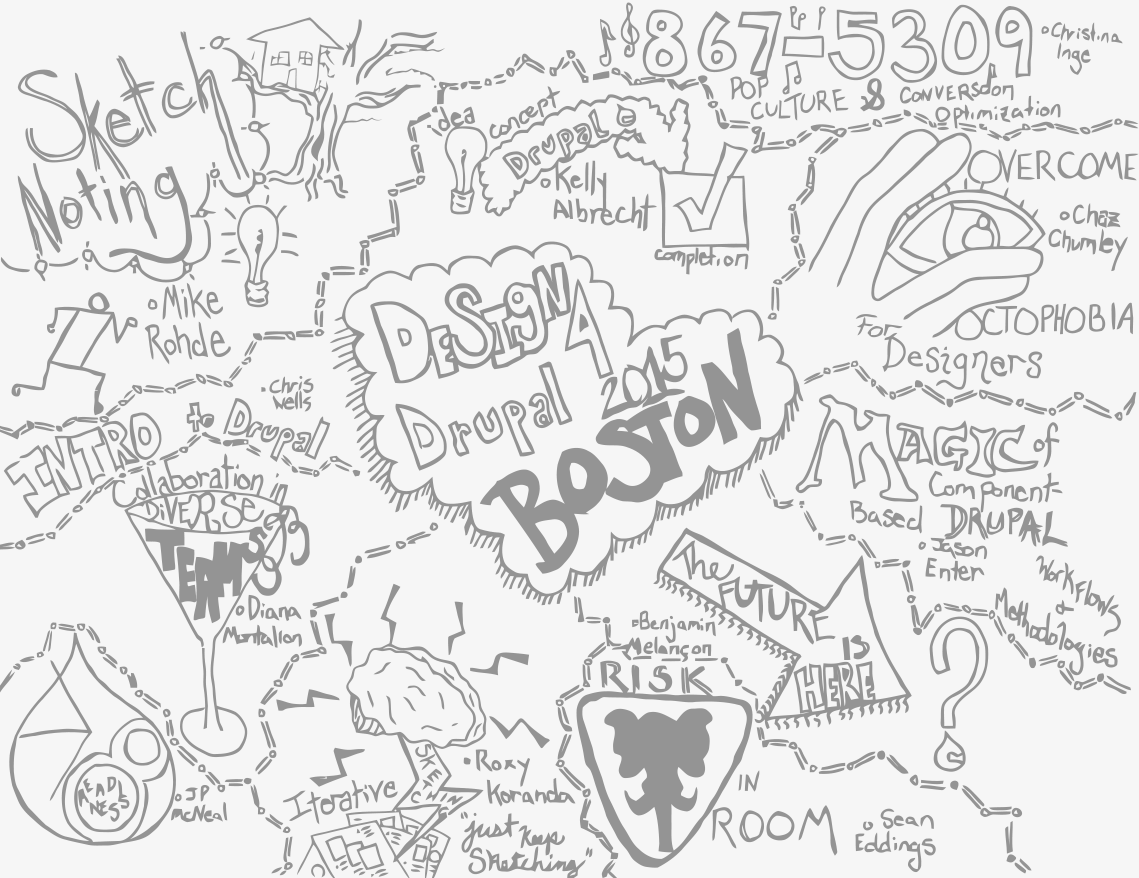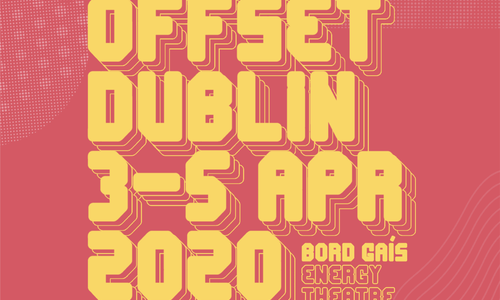
I present my SketchNote of Design 4 Drupal 2015!
Design 4 Drupal 2015 took place at the beautiful Microsoft NERD Center in Boston this past weekend. While I left the conference with a ton of questions, one being how anything possibly gets done in that building with such a beautiful view of the Charles, I feel I learned quite a bit! Sessions ranged in topic covering the basics of Drupal & Drupal 8 for designers (or simply non-drupal initiated folks like my administrator self) to outlining how to involve sketching in every step of your product’s creative process. Here are some of the sessions that were inspiring and helpful to me.
The talk that spearheaded the conference was our own Sean Eddings on “The Elephant in the Room: Risk”. Whether we like to admit it or not, everything we do involves some amount of risk, especially in creating products for clients. In a memorable slide Sean equated talking about this elephant in the room to a phrase I heard often growing up, “Eat your vegetables!”. It’s not always easy and we may not want to do it, but we’re always better off! Have an open and honest conversation about risk with your team and your clients. (Truth: Last Call Media loves vegetables! Check out our blog on our company sponsored CSA shares.)
I found Diana Montalion’s keynote particularly fascinating. As we are all, hopefully now, painfully aware of the racial and gender gaps that exist in the workplace, and in tech in particular, Diana hammered home that these are only the top of a long list of differences that cannot be overlooked when discussing diversity. Understanding and embracing these differences is imperative to collaborating in a way that is best for business and team members alike. We need to take stock of exactly what and who we’re promoting (translate: excluding) when, for example, every company outing or launch party involves a keg and ping pong. For team members, like myself, who much prefer a cocktail or glass of wine, it is much more inviting to have a rotation of various locations and types of venues for these events. My takeaway is to get to know all of your team, embrace their differences and you’ll be a stronger team for it.
Sketching, surprise surprise, emerged as a main theme at this designer conference between Mike Rohde’s keynote “Lessons Learned from Sketchnoting” and Roxy Koranda speaking on “Iterative Sketching”. Through a mini course on the basics of drawing and a timed exercise of sketching treehouses, Mike inspired us to think and document our notes visually. Not only are these “sketch notes” more fun than traditional note taking, they’re also more suitable for idea retention. By focusing on the main ideas of a presentation and notating them visually we more deeply root these memories by combining auditory and visual information. Also, did I mention how much fun they are? Just make sure to tell your boss or client you’re using this technique before they think you’re simply doodling throughout your work meetings. Don’t say I didn’t warn you!
Roxy’s presentation focused on bringing sketching into every step of our client deliverable process and not limiting it to the design stage. She made a great point that we have more freedom to quickly sketch all of our ideas (even the bad ones) before we start making comps of our only idea. In my sketchnotes I depicted this as sketch brainstorming. It’s tempting to jump into comps of early ideas due to time or other constraints but if we “just keep sketching” then we can make the best product and not our only product.
As I’m personally new to the Drupal community, I found Chris Well’s “Intro to Drupal Workshop” and Chaz Chumley’s “Overcoming Octophobia: For Designers” very enlightening. While I still have a long way to go, thanks to them I have a much better understanding of what Drupal is, how it works, its vocabulary and changes to expect in core this time around. Oh hey, Twig!
For the developers on our team, Jason Enter’s talk on “Workflows and Methodologies of Component-Based Drupal” was more their speed. His case study of the Magic: The Gathering site was particularly helpful in exemplifying his techniques. I urge you to check out the site, it’s visually stunning and super user friendly. “Drupal 8 Readiness” is, of course, on every drupal dev’s mind and JP McNeal pointing out that we can watch Drupal 8 Release Progress in real time on Android Wear blew those minds right up. Whaaat? Sorry, Apple folks, only for Android at the time of this writing.
The session that’s still ringing in my ears (how many days later?) is Christina Inge’s aptly named “867-5309: Pop Culture, Mental Shortcuts and Conversion Optimization”. If the title didn’t clue you in, Christina stressed that we can use pop culture references in our branding and content to have our ideal customers and clients self-select. As a psych major, I loved seeing Cognitive Load Theory utilized in UX and design, as well. Basically, the concept is that we want site users perfectly engaged in order to read on, click “buy” or complete whatever business we require. How often are we overwhelmed or underwhelmed with the information or lack thereof and simply click away? Yea, that’s the opposite of what we want on our sites. Wield the sword of Psychology to create the perfect balance of sensory input for your target audience in a way that’s authentic to you and your brand. Also, we’ll remember Tommy Tutone for the rest of our lives.
There were so many amazing people and presentations at this year’s D4D. Discussions, including the future of Drupal spurred by Benjamin Melançon’s presentation, were incredibly eye-opening as well as thought provoking. This was my first time attending Design 4 Drupal and I know it won’t be the last.




